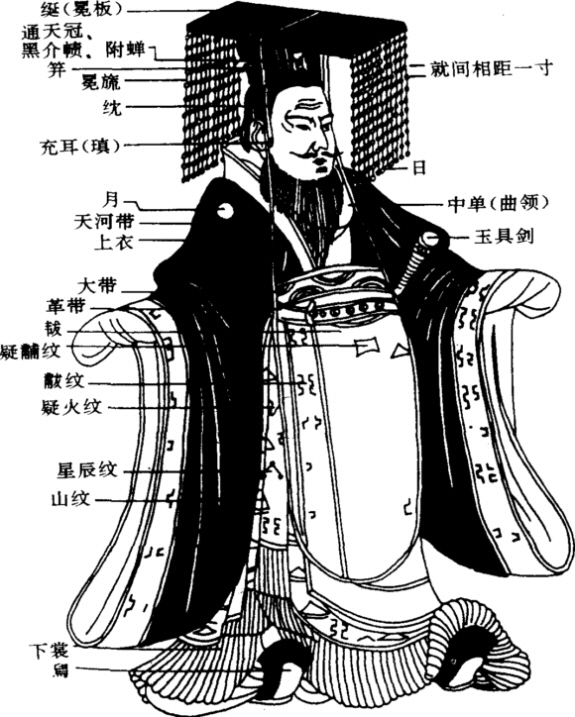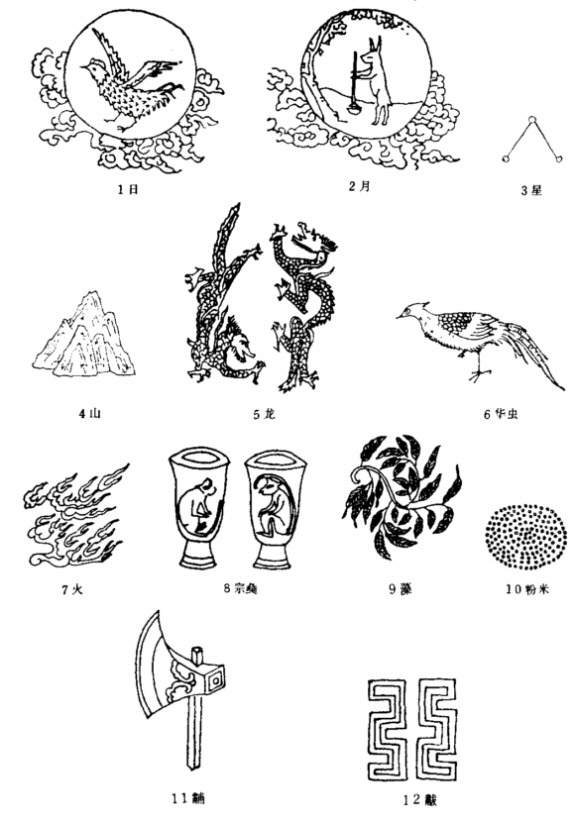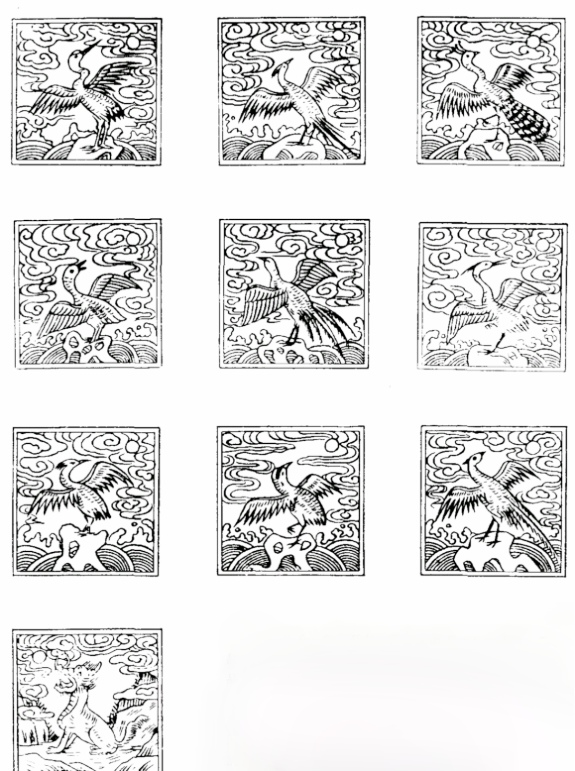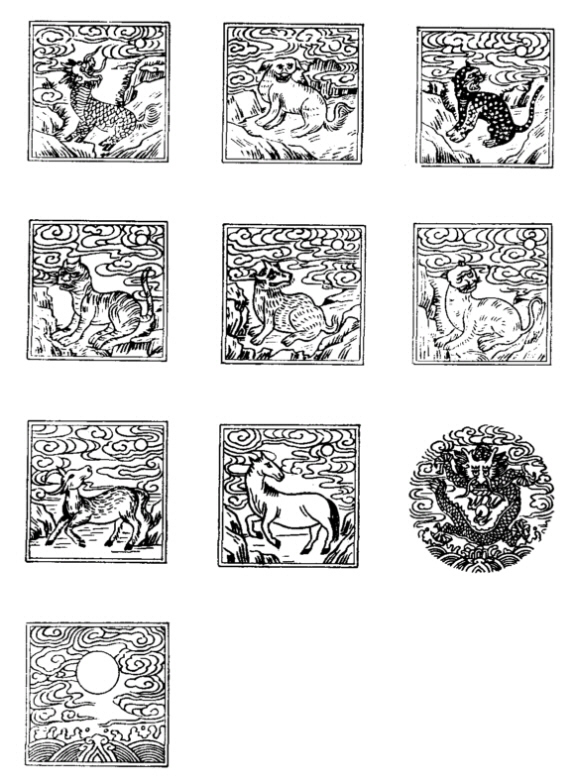Chapter 17 Section 3 Clothes and Clothes
Clothing is the most exposed form in social life, and it is the easiest to mark a person's status. Therefore, it has been valued by the rulers of all dynasties since ancient times.Since the Xia and Shang dynasties, there have been certain rules for clothing, and a set of crown clothing system has gradually formed in the Zhou Dynasty.Since then, emperors, concubines, dignitaries and even common people have their own styles of clothing due to their different status.Dresses for different occasions also have special attention.
A crown is a hat worn by ordinary noble men.In ancient times, after a man held a crown ceremony at the age of 20, the crown became a symbol of adulthood, so he had to wear it in public.It is indecent behavior to wear a crown instead of it. "Book of the Later Han Dynasty: Ma Yuan Biography" records that when Ma Yuan was not an official, he "respected his widowed wife, and he was not in the house if he was not crowned".This shows that it is impolite for educated scholars not to wear crowns. "Zuo Zhuan Fifteen Years of Duke Ai" records the civil strife in Wei. Confucius' disciple Zilu was wounded by a dagger in the melee, and the tassel of his crown was also cut off.At this critical moment when life was at stake, Zilu also said: "When a gentleman dies, the crown is unavoidable." He endured severe pain and reattached the crown before he died.This shows that Zilu values wearing a crown more than life.
The crowns worn by the emperor, princes and officials when offering sacrifices are called crowns.The shape of the crown is different from that of ordinary crowns. The upper part is a black rectangular wooden board called "extension" (or written as "綖"), and the lower part is connected with the crown and worn on the head.There are strings of small round jade hanging on the front and rear edges of the extension, which are called "旒 [liu flow]".The number of 旒 also varies with different identities.According to literature records, the crown of the Son of Heaven is twelve at the front and back, nine for the princes, seven for the upper official, and five for the lower official.After the Han Dynasty, only the emperor could wear Mian You'an, so "Mian You'an" became the emperor's synonym (see Figure 2).

Figure 2 Names of Ancient Crown Clothes Parts
In ancient times, except for children and ethnic minorities, ordinary people and criminals did not wear crowns, so the removal of crowns by scholars meant lowering their status. "Historical Records Biography of Prince Wei" records that Pingyuan Lord Zhao Sheng offended Xinling Lord Wei Gongzi Wuji, and Xinling Lord planned to leave Zhao.When Mr. Pingyuan learned that he had wrongly blamed Mr. Xinling, he "removed his crown and thanked him (accompanying the crime), and stayed with you son".He took off the crown to show that he was at fault and demeaned himself in this way.As for the common people, they are not allowed to wear crowns, they can only be covered with a head [ze responsibility]. "Han Guan Yi" says: "The headband is the clothes of the humble and deacons in ancient times." (Qian is black); Han called servants "Cangtou" (Cang is cyan).Because the headband itself has the function of pressing hair and fixing the crown, it was later developed that the nobles also wore the headband, but a crown was added to the headband.Later, there appeared a capped headband, which does not need to be crowned.
After the Tang and Song Dynasties, the ranks of wearing crowns began to be confused.For example, in the Sui and Tang Dynasties, Futou (similar in shape to the black gauze hat commonly known as later generations) had been used as official uniforms, but in the Song Dynasty, most men also wore this kind of hat.So the ruler began to make a fuss about the crown.Crown decorations are used to distinguish grades, with Dingzi and Hualing in the Qing Dynasty being the most typical.Dingzi, also known as "Dingdai" and "Dingzhu", are jewels and other ornaments of different colors adorned by officials of the Qing Dynasty on the court crowns and auspicious costume crowns.According to the Qing Huidian, rubies are used for crowns of officials of the first rank, corals for the second rank, sapphires for the third rank, lapis lazuli for the fourth rank, crystal for the fifth rank, giant clams for the sixth rank, and plain for the seventh rank. Golden dome, eighth grade gold dome with engraved Yinwen, and ninth grade Yangwen golden dome with engraved flowers.Hualing is a crown decoration made of peacock feathers, which is inserted on the ceremony crown and hangs behind the crown to decorate and distinguish the rank of officials.Hualings are divided into single-eyed, double-eyed and triple-eyed (the bright and bright circle at the end of the Hualing is called the eye), and the one with the most feathered eyes is the most expensive.According to "Manuscripts of Qing History · Li Zhi" and "Cases of Qing Huidian · Ministry of Rites", among members of the royal family, the titles of the members of the royal family are lower than those of the prince, the county king, Baylor's beizi and Gu Lun's forehead (husband of the princess born to the queen), and they are eligible to wear three crowns. Dazzling feathers; the nobles in the imperial family and vassals of the Qing Dynasty who were named Zhen Guogong and Fu Guogong, as well as Heshuo's forehead (husband of the princess born to concubines) wear double-eyed feathers; officials above the fifth rank and ministers in the palace, As well as the commanders of the forwards and guards, and the participating leaders Dai single-eyed Hualing.Officials below the sixth rank can only wear blue feathers, which are ornaments made of 鹖 (he river) feathers dyed blue.According to regulations, Dingzi and Hualing are not allowed to overstep.If an official is dismissed, he will take off his top-wearing feathers as a sign.
During the Shang and Zhou dynasties, the style of clothing was usually upper garments and lower garments, which were skirts, which could be worn by both men and women.It is a sign of noble status that noblemen wear an additional piece of leather or silk embroidered ax-shaped clothing outside their skirts.In the Spring and Autumn Period, the upper garment and the lower garment were connected, and the lower part hung down to the ankle, which was called "deep clothing".When making deep garments, the upper and lower parts are still cut, and then sewn together.The lower garments share 12 pieces, in order to reflect the meaning of December every year, and to express the respect of the ancients for the weather.Deep clothing has a wide range of uses, and princes, doctors, and scholars can wear it not only at home, but also in the evening.Common people generally wear brown [hehe], but dark clothes can also be used as dresses.Shenyi has a great influence on the clothing of later generations, and modern dresses are also evolved from Shenyi.
In ancient times, winter clothes for keeping out the cold included furs and gowns.Fur is a fur garment, with animal hair outside, and it must be worn according to the grade.In ancient times, fox fur was the most expensive, and it was mainly worn by kings and nobles.Fox fur is divided into fox white fur, fox green fur, fox yellow fur, fox green fur and so on.According to "Baihu Tongyi Clothes Chapter": "The son of heaven has a white fox, the princes have a yellow fox, and the doctor wears gray." Scholars generally wear tiger fur, wolf fur or lamb fur, while ordinary people can only wear dog and sheep fur.Fur clothing can be worn directly, but when holding ceremonies and receiving guests, it is necessary to wear a 〔xixi〕 clothing over the fur clothing, otherwise it will be regarded as disrespectful and disrespectful.The gown was originally a thick long gown filled with hemp and old silk cotton, and was worn by the poor.Therefore, in the pre-Qin period, there was a significant difference between rich and poor in wearing fur or robes.
After the Qin and Han Dynasties, in order to maintain the ruling order, the clothing hierarchy became more and more perfect.Officials at all levels and ordinary people have obvious differences in clothing and clothing, from styles, materials, colors, and patterns, and there must be no mistakes.For example, after the Tang and Song Dynasties, dragon robe and yellow became the exclusive clothing colors of the royal family, and "yellow robe plus body" has become a synonym for ascending the throne of the emperor, so others must not use it arbitrarily, otherwise it will be regarded as "rebellious".For other officials, "from the first rank to the fourth rank, the Fei [feifei] gown; from the fifth rank to the seventh rank, the blue gown; from the eighth rank to the ninth rank, the green gown." Crow blue, so as not to be confused with official uniforms.
The level of clothing is particularly evident in dresses and official uniforms.The dresses of ancient emperors and senior officials were embroidered with 12 kinds of patterns, namely the sun, moon, stars, mountains, dragons, Chinese insects (pheasants), fire, Zongyi (a sacrificial ritual vessel), algae (a kind of aquatic plants), Fenmi (white rice), Fu [fu Fu, ax-shaped], Fu [fu Fu, two bows facing each other], commonly known as twelve chapter patterns (see Figure 3).These patterns have symbolic meanings.According to the analysis of the ancients, the sun, the moon, and the stars symbolize presence and light; mountains symbolize tranquility; dragons symbolize adaptability; Chinese insects symbolize the virtue of articles; fire symbolizes light; Fu symbolizes determination; Fu symbolizes the mutual assistance of the monarch and his ministers, turning away from evil and turning to good.Twelve chapter patterns have a long history and have been formed around the Zhou Dynasty, but before the Qin Dynasty, they were only auspicious patterns on clothing.It was not until the Eastern Han Dynasty that the chapter and clothing system was truly established as an important part of the feudal etiquette system.From then until the Qing Dynasty, the twelve chapter patterns have been used as the costumes of the emperor and officials.Although there are some differences in the usage of chapter patterns in different dynasties, they are similar. Just take the Tang Dynasty as an example to know the general idea.

Figure 3 Twelve chapter patterns (quoted from "History of Ancient Chinese Costumes", China Drama Publishing House, 1984 edition)
In the fourth year of Tang Wude (621 A.D.), the imperial court issued an imperial edict announcing the orders for cars, clothing and clothing, "uppers can be combined with lower ones, and lower ones are not allowed to be upper", and those who violate it will be punished.Its specific regulations: Only the emperor can use twelve chapters in the world; the crown prince and first-rank officials can take nine chapters, "Dragon, Mountain, Huachong, Huo, and Zongyi are in the clothes, and algae, rice, 軼, and 軻 are in the clothes"; The seven chapters of taking the product, "Hua Chong, Huo, and Zongyi are in the clothes, Zao, rice flour, Fu, and Fu are in the clothes"; For the fourth grade, take three chapters, "the powdered rice is in the clothes, and the fur and fur are in the clothes"; for the fifth grade, take one chapter, "the clothes are stabbed and the fu is one chapter" ("New Tang Book · Car Service System").
During the Ming and Qing Dynasties, the emperor's court clothes still used twelve chapters, while civil and military officials changed their clothes to supplementary clothes.Bufu is also called mending coat, which is an additional emblem on the regular clothes, called "buzi", which is embroidered on the front chest and back, embroidered with gold thread and colored silk, so that people can know their official titles and titles at a glance. grade.During the Hongwu period of the Ming Dynasty, it was stipulated that: Gong, Hou, son-in-law, and Bo Buzi embroidered Qilin and Baize.The supplements of civil officials use bird patterns, among which the first-rank civil officials embroider cranes, the second-rank embroidered golden pheasants, the third-rank peacocks, the fourth-rank wild geese, the fifth-rank white pheasants (xian Xian), the sixth-rank egrets, and the seventh-rank 鸂鶒 [xi chi Xi Chi] 〕, eighth grade oriole (changed to quail in the Qing Dynasty), nine grade quail (changed to Lianque in the Qing Dynasty) (see Figure 4).The supplements of military officers use animal patterns, among which the first-rank military officers embroider lions (changed to Qilin in Qing Dynasty), the second-rank also use lions, the third-rank use tigers (change to leopard in Qing Dynasty), and the fourth-rank use leopards (change to tiger in Qing Dynasty). , the fifth-rank bear (pi skin), the sixth-rank and seventh-rank Yongbiao (the seventh-rank is rhinoceros in Qing Dynasty), the eighth-rank rhinoceros, and the ninth-rank seahorse (see Figure 5).There are several small changes in the pattern of Buzi in Ming and Qing Dynasties, but the nature of the distinction between grades is the same.In addition, there are dragons and pythons embroidered on the Buzi of the royal family and nobles in the Qing Dynasty, indicating a higher status.For example, for the prince's mending clothes, there are four golden dragon mendings on the front, one on the front chest, one on the back and one on both shoulders; for the prince's mending clothes, there are four golden dragons, the front and back mendings are positive dragons, and the two shoulder mendings are Xinglong; , four Xinglong patches, one on the front, one on the front, and one on each shoulder; Baylor patch, one patch on the front, one on the front, and the pattern is a regular python;

Civilian complement.From left to right, and then from top to bottom, the first rank is crane, the second rank is golden pheasant, the third rank is peacock, the fourth rank is geese, the fifth rank is white pheasant, the sixth rank is egret, the seventh rank is ostrich, the eighth rank is quail, the ninth rank is Lianque, and the royal censor Xiezhi Picture 4 Patterns of Buzi for civil servants in the Qing Dynasty (quoted from "History of Ancient Chinese Costumes", China Drama Publishing House, 1984 edition)
The patch on it is relatively simple, but the real thing is much more gorgeous, with blue and green shades of cloud patterns on a glittering gold ground, interspersed with patterns of eight treasures and eight auspicious signs.Add a golden rim all around.For example, birds mostly use white, and beasts such as leopards use orange-yellow leopard skin color.Generally, the length and width are equal, making a square, between 29 cm.

Military officer Buzi.From left to right, then top to bottom.In Shangwu, the first-rank unicorn, the second-rank lion, the third-rank leopard, the fourth-rank tiger, the fifth-rank bear, the sixth-rank biao, the seventh-rank and eighth-rank rhinoceros, and the ninth-rank seahorse.The five-clawed golden dragon of the prince, and the colorful cloud holding the sun from the farmer's official.
Figure 5. The pattern of the military officer Buzi in the Qing Dynasty (quoted from "History of Ancient Chinese Costumes", China Drama Publishing House, 1984 edition)
Official uniforms are generally worn when performing official duties and attending ceremonies, and officials can also wear casual clothes at ordinary times.There are also etiquette rules for when and what clothes to wear, and you can't wear them indiscriminately.Officials, regardless of their superiors or subordinates, if they meet formally, one party should wear official uniforms and the other party should also wear official uniforms to receive them.The subordinates wear official uniforms to meet the superiors. If the superiors do not wear official uniforms to meet, it is considered rude, and the subordinates may even refuse to meet.
In addition, the colors of ancient costumes can be divided into plain colors and happy colors.Generally, white, black, gray, and blue are plain colors, and red, vermilion, pink, etc. are happy colors.According to etiquette, plain and happy clothes should be worn according to different situations.It is impolite to wear plain clothes to a festive occasion, or to wear a red wedding dress to a funeral.In the forty-third chapter, it is written that Jia Baoyu was "vegan all over the body" at first, and went to the Narcissus Nunnery outside the city to burn incense and pay homage to Jin Chuan'er; Go up", then go to the Dahua Hall to congratulate Sister Feng on her birthday, salute and have a drink.This is what counts as "perfect etiquette".

Figure 2 Names of Ancient Crown Clothes Parts

Figure 3 Twelve chapter patterns (quoted from "History of Ancient Chinese Costumes", China Drama Publishing House, 1984 edition)

Civilian complement.From left to right, and then from top to bottom, the first rank is crane, the second rank is golden pheasant, the third rank is peacock, the fourth rank is geese, the fifth rank is white pheasant, the sixth rank is egret, the seventh rank is ostrich, the eighth rank is quail, the ninth rank is Lianque, and the royal censor Xiezhi Picture 4 Patterns of Buzi for civil servants in the Qing Dynasty (quoted from "History of Ancient Chinese Costumes", China Drama Publishing House, 1984 edition)

Military officer Buzi.From left to right, then top to bottom.In Shangwu, the first-rank unicorn, the second-rank lion, the third-rank leopard, the fourth-rank tiger, the fifth-rank bear, the sixth-rank biao, the seventh-rank and eighth-rank rhinoceros, and the ninth-rank seahorse.The five-clawed golden dragon of the prince, and the colorful cloud holding the sun from the farmer's official.
Figure 5. The pattern of the military officer Buzi in the Qing Dynasty (quoted from "History of Ancient Chinese Costumes", China Drama Publishing House, 1984 edition)
